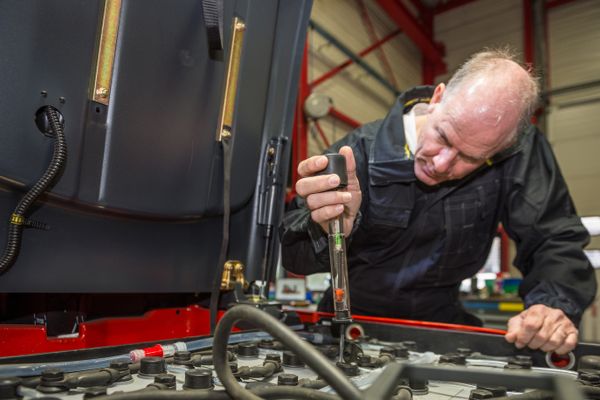Battery Safety

Batteries provide a portable – and usually safe – source of electrical power for countless applications. From tiny cells used in wristwatches to industrial-size utility backups, batteries keep things working for us.
There are some hazards associated with batteries, however. The chemical reactions required to generate electricity involve toxic and explosive substances, harmful to humans and the environment. Large batteries can deliver fatal electrical shock.
Consider the many uses for batteries in your workplace, such as personal lights, UPS (Uninterruptible Power Supply) units for electronic equipment, power for handcarts and forklifts, alarm and testing equipment, clocks, communications and bar code readers.
Batteries produce hydrogen gas, also known as H2. This gas is explosive. When an accumulation of hydrogen gas mixes with oxygen in the air and meets an ignition source such as a spark, an explosion occurs. The result is often an eye injury from fragments of a battery or tool. The explosion also propels the hazardous content of the battery, such as sulfuric acid or lead. While it does not happen often, even an ordinary flashlight can explode.
Excess hydrogen gas is likely to be produced when batteries are being charged, and when batteries are mismatched, connected incorrectly, damaged, overcharged or otherwise misused.
These general safety tips apply to batteries of all sizes:
- Read and follow the manufacturer's instructions.
- Do not mix batteries of different brands.
- Do not mix old and new batteries.
- Do not mix batteries of different types, such as alkaline and non-alkaline, or rechargeable and non-rechargeable.
- Do not use damaged or leaking batteries.
- Observe the correct polarity when installing batteries.
A battery explosion is a serious matter in any work environment, but especially when the atmosphere of the work area is flammable. For use in hazardous atmospheres, observe all safety precautions to prevent fire and explosion. As directed, use lights and batteries designed to minimize the hazards of sparks. Make sure the batteries are in good condition and installed correctly. Open the battery compartment to allow any accumulated hydrogen gas to escape. Of course, you must not inspect your light in a hazardous area or near an open flame.
Many workplaces have battery rooms where large batteries that power mobile equipment are charged and changed. Handling these batteries requires special training to prevent explosions and other kinds of exposure. The rooms have to be well ventilated. Workers need to use the correct battery lifting devices to avoid injury. Heavy batteries being moved from delivery vehicles to storage can also fall and crush toes.
Large stationary batteries are also present in utility settings where they provide temporary power in an outage until the fuel-powered generator kicks in.
These high voltage batteries are stored in secure, well-ventilated power rooms. Only trained, authorized personnel who know how to avoid shock, electrical arcing, blast and chemical hazards should handle them. Even an apparently discharged battery of this size can retain enough electrical power to kill. Combustible materials, sources of ignition – and unauthorized personnel – must be kept away from these areas.
